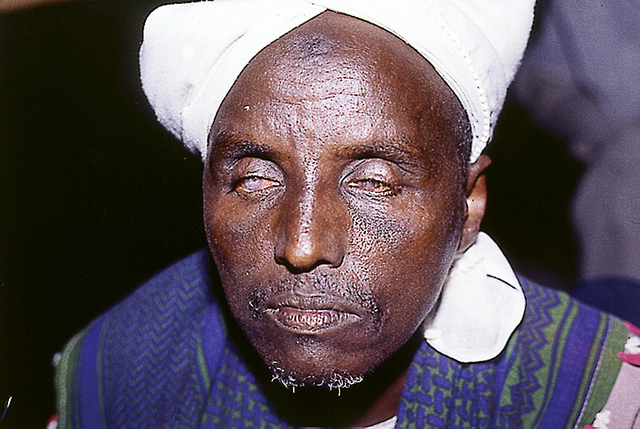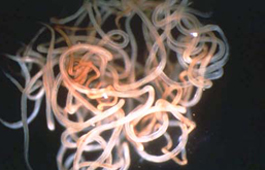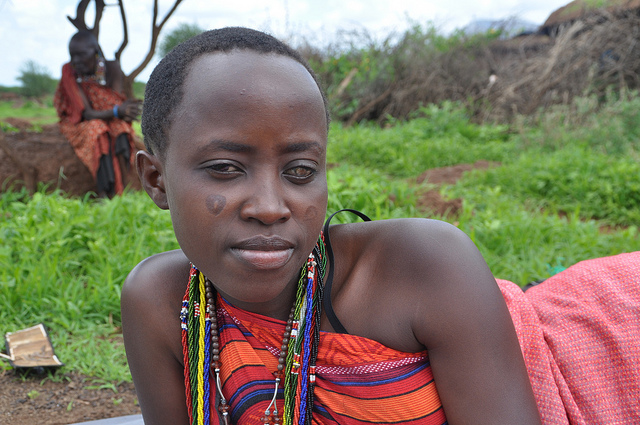Form and Function
 The Onchocerca volvulus parasite can only survive when it is
inside of a host. Once it is attached to its host, the female
disburses her larvae into the skin and tissue of the host, where the
parasites begin to grow and mature into adults. After mating, the
pregnant females then release thousands of larvae into the
bloodstream of the host. These larvae are responsible for the
diseases in which the host accumulates including dermatitis,
lymphadenopathy, and most commonly, blindness (Truant
1998). Onchocerca
volvulus is the second leading cause of blindness in the world
(Globisch 2013).
The Onchocerca volvulus parasite can only survive when it is
inside of a host. Once it is attached to its host, the female
disburses her larvae into the skin and tissue of the host, where the
parasites begin to grow and mature into adults. After mating, the
pregnant females then release thousands of larvae into the
bloodstream of the host. These larvae are responsible for the
diseases in which the host accumulates including dermatitis,
lymphadenopathy, and most commonly, blindness (Truant
1998). Onchocerca
volvulus is the second leading cause of blindness in the world
(Globisch 2013).
The life cycle of a Onchocerca volvulus starts out when an
infected larvae bites on a human host, which is similar to the
insect
Aedes aegypti because they also host upon humans. The transfer
of Onchocerca volvulus is similar to the parasite
Babesia caris as it is also transferred through the bite of
an insect. Babesia
caris, is transferred by a tick into a
host of a dog or fox rather than a human where it then leads the
host to feeling very unwell and can sometimes even lead to death. The larvae then
develops into an adult worm in the dermis or connective tissue of
the host. These female worms live in coiled-up
subcutaneous tissues
and can be anywhere from 30 to 80 centimeters in length. The
females also produce 700- 1500 microfilarias, the embryonic larva of
the nematode in a single day.
Dracunculus medinensis is similar to Onchocerca volvulus
because after they reproduce, the female worms both migrate to
subcutaneous tissues of the human body. The male larvae tend to move freely in
the skin tissues of the host where it is typically 3-5 centimeters
long. The microfilariae produced by the female then migrate
throughout the body of the host into the upper dermis and eyes
(Institutional Links 2013).
transferred by a tick into a
host of a dog or fox rather than a human where it then leads the
host to feeling very unwell and can sometimes even lead to death. The larvae then
develops into an adult worm in the dermis or connective tissue of
the host. These female worms live in coiled-up
subcutaneous tissues
and can be anywhere from 30 to 80 centimeters in length. The
females also produce 700- 1500 microfilarias, the embryonic larva of
the nematode in a single day.
Dracunculus medinensis is similar to Onchocerca volvulus
because after they reproduce, the female worms both migrate to
subcutaneous tissues of the human body. The male larvae tend to move freely in
the skin tissues of the host where it is typically 3-5 centimeters
long. The microfilariae produced by the female then migrate
throughout the body of the host into the upper dermis and eyes
(Institutional Links 2013).
Another fly can get infected if it feasts on a host which is already
infected by the parasite. When a blackfly ingests a microfilariae
with its blood meal it can very easily pick up the parasite. The
microfilariae then enters the first larval stage where it remains
until it matures and then takes over the saliva of the fly. As the
fly the finds its next host, human or animal, the larvae then
passes into the host’s bloodstream and the cycle starts all over
again.
If a person is affected by Onchocerca volvulus in the area of the
eye, it can lead to severe damage of the eye and even lead to
blindness. However, if it is noticed in the early stages, it can be
cured by the use of drugs that kill the larvae in the body which is
the source of inflammation in the eye. This treatment however, can
take a very long time and can last anywhere from 10 to 15 years
because that is the lifespan of the matured worm present in the
humans body (Onchocerciasis 2006).

Blindness has been a huge fear of many Africans because of the
terrible effect that it can have on not only a persons life, but it
can also be a burden for the people around them as well. Many people
in Africa have therefore chosen to move away from the rivers and
savannahs for fear that they may catch the parasite. This
has lead to decreasing amounts of productivity and agriculture in
these fertile soil areas which inturn increases poverty in these
areas as well (World Health Organization 2014).
Onchocerca volvulus is a
very mobile parasite that can travel fast because of it’s ability to
transfer through humans, animals, and black flies. This can be very
harmful to humans, just as
Sarcaphaga carnaria and
Naegleria fowleri which also use humans as hosts of the
parasites, because you can potentially get it anywhere, at
any time. Even though there is new research being conducted on drugs
that can help the early effects of the parasite, there are still
these organisms living in a persons' body, which can live in a body
for sometimes over 15 years. With more technology and studies being
done on this organism, we can find a better way to keep humans safe
and keep this detrimental organism contained.
Let's learn about the life history and reproduction of this parasite!